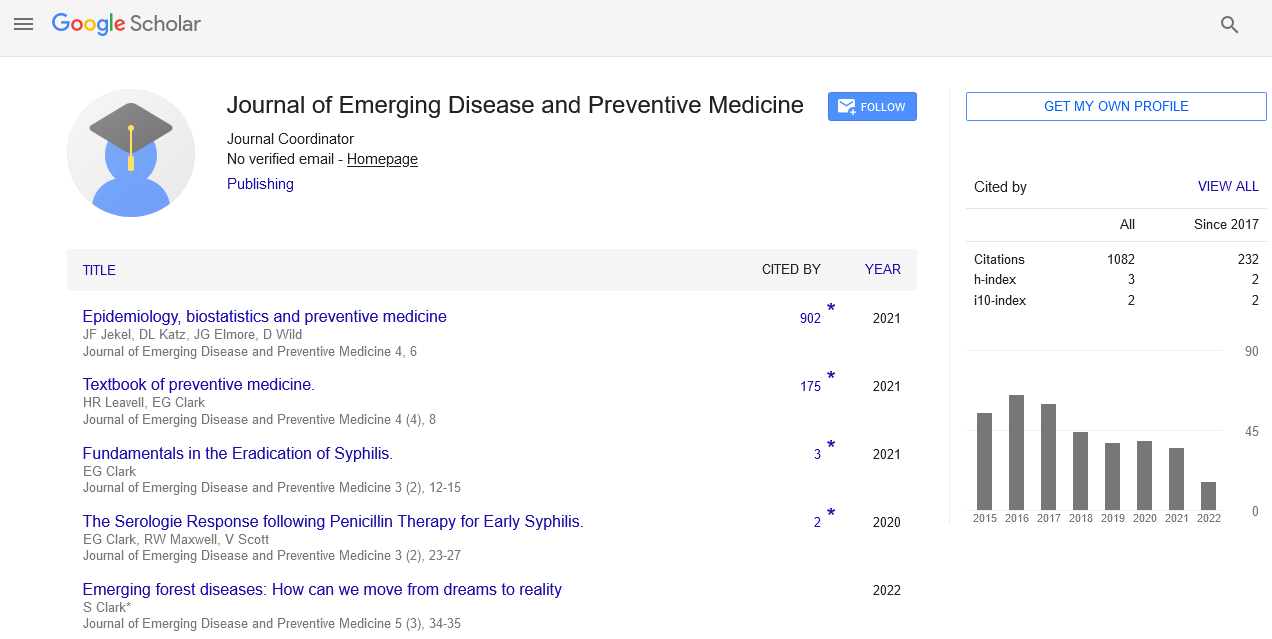Severe acute respiratory syndrome
Received: 06-Feb-2022, Manuscript No. PULJEDPM-22-4392; Editor assigned: 09-Feb-2022, Pre QC No. PULJEDPM-22-4392; Accepted Date: Feb 06, 2022; Reviewed: 22-Feb-2022 QC No. PULJEDPM-22-4392; Revised: 25-Feb-2022, Manuscript No. PULJEDPM-22-4392; Published: 27-Jun-2022, DOI: 10.37532/puljedpm. 2022;5(2):13-14.
Citation: Blake E. Severe acute respiratory syndrome: A literature review. J Emerg Dis Prev Med. 2022;5(2):13-14.
This open-access article is distributed under the terms of the Creative Commons Attribution Non-Commercial License (CC BY-NC) (http://creativecommons.org/licenses/by-nc/4.0/), which permits reuse, distribution and reproduction of the article, provided that the original work is properly cited and the reuse is restricted to noncommercial purposes. For commercial reuse, contact reprints@pulsus.com
Abstract
SARS was caused by a previously unknown animal coronavirus that adapted to become a virus easily transmissible between humans by taking advantage of possibilities afforded by 'wet markets' in southern China. Hospitals and foreign travel served as 'amplifiers,' allowing a local infection to spread globally. We will address the significant scientific progress achieved in understanding the virus—SARS coronavirus (SARS-CoV)—and the disease in this review. We'll also talk about how far we've come in terms of producing vaccines and treatments. SARS was limited thanks to a determined and coordinated response that is a win for global public health and sets a new standard for det
Key Words:
China; Epidemic; Remdesivir; Sars-cov-2
Introduction
Southern China has had three pandemics: plague in the late 1800s and two influenza pandemics. A new 'plague' was spreading in Guangdong Province, China, in November 2002. On February 21, 2003, a Guangdong physician spent a single day in Hong Kong's hotel 'M,' during which time he infected 16 other guests. As a result, illness epidemics spread to Hong Kong, Toronto, Singapore, and Vietnam3. SARS had infected almost 8,000 persons in 25 countries across five continents in just a few weeks. It had killed 774 people by the conclusion of the global outbreak (5 July 2003), which was a tiny figure in contrast to the number of people who died.
The global outbreak (5 July 2003), it had killed 774 people—a small number in comparison with the fatalities during the previous pandemics of plague and influenza. But the rapidity of spread by air travel, immediate media coverage and today's globalization of economic activity all contributed to the far more pronounced impact of SARS. The scientific response to this novel viral disease was unprecedented in its quickness. Within weeks of the virus's emergence from mainland China, the clinical illness was characterised, the etiological agent was discovered, diagnostic tests were developed, and the genome was completely sequenced. After only 1.5 years, the first phase 1 vaccination trials have begun, and numerous more vaccine candidates are being tested in animal models. Clinical presentation, aetiology, virology laboratory diagnosis, epidemiology, infection control, clinical care, and public health. Here, we focus on pathogenesis and its relationship to clinical outcomes, as well as the progress achieved toward antiviral treatment and vaccine development.
THE VIRUS, ITS ORIGINS AND EVOLUTION
SARS probably first emerged in Guangdong around November 2002. Many of the affected individuals in November and December 2002 had contact with the live-game trade. The disease was described as an “infectious atypical pneumonia” because of its propensity to cause clusters of disease in families and healthcare workers. The etiological agent of SARS was identified as a new coronavirus not previously endemic in humans. The lack of serological evidence of previous infection in healthy humans suggested that SARS-CoV had recently emerged in the human population and that animal-to-human interspecies transmission seemed the most probable explanation for its emergence. Specimens collected from apparently healthy animals found in live wild-game animal markets in Guangdong yielded a SARS-CoV-like virus with more than 99% nucleotide homology to the human SARS-CoV. But the wild-animal reservoir in nature still has not been identified conclusively. Many workers who handled animals in these wet markets had antibody to the related animal SARS-CoV-like virus although they had no history of a SARS-like isease.
CLINICAL SYMPTOMS
The clinical symptoms of SARS-CoV infection are those of lower respiratory tract disease. Besides fever, malaise and lymphopenia, affected individuals have slightly decreased platelet counts, prolonged coagulation profiles and mildly elevated serum hepatic enzymes. Chest radiography reveals infiltrates with sub pleural consolidation or 'ground glass' changes compatible with viral pneumonitis. But although the main clinical symptoms are those of severe respiratory illness, SARS-CoV actually causes infection of other organs: some affected individuals have watery diarrhea, and virus can be cultured from the feces and urine, as well as the respiratory tract. In addition, RT–PCR has identified the virus in the serum, plasma and peripheral blood leucocytes. Individuals with SARS also have a pronounced peripheral T-cell lymphocytopenia: numbers of CD4+ and CD8+ cells are both reduced, and more than around 20%-30% of individual als with SARS require management in intensive care units and the overall fatality rate is ∼15% (World Health Organization, one-third of individuals have a CD4+ T-cell count of less than 200 cells/mm3 , suggesting increased susceptibility to secondary infections. The mechanisms underlying the T-cell lymphopenia remain to be elucidated.
VIRUS TROPISM AND PATHOGENESIS
In Quantitative studies of viral load have provided insights into the pathogenesis of SARS. Viral load is higher in the lower respiratory tract than in the upper airways. Viral load in the upper respiratory tract and feces is low during the first 4 days and peaks at around day 10 of illness. In marked contrast, viral load in influenza peaks soon after onset of clinical symptoms. This unusual feature of SARS-CoV infection explains its low transmissibility early in the illness. It also explains the poor diagnostic sensitivity of the first-generation RT–PCR diagnostic tests on upper respiratory tract and fecal specimens collected early in the field.





